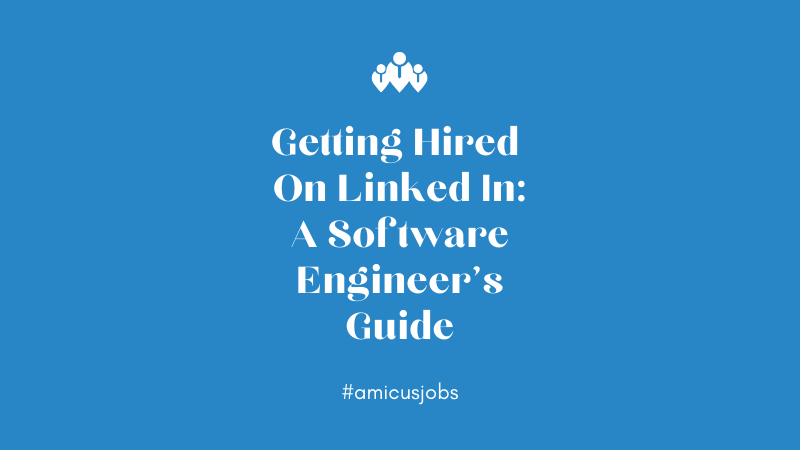How to Make a Killer Profile To Get Hired on Linked In
Linked In isn’t necessarily every software engineer’s go-to platform to keep in the loop with all things tech. GitHub, Stack Overflow and other programming hubs like podcasts are the usual suspects for daily updates, projects and networking.
But, if you’re looking for your next role, or want to collaborate or raise your status among your peers on a professional level, are these sites really the best tool?
Do I Need Linked In?
Linked In is the number one social networking platform for networking. It doesn’t matter which sector you work in, if you want to progress, improve and highlight successful aspects of your career, Linked In is where you should be looking.
But, with that in mind, should software engineers have a Linked In profile? You might wonder, ‘Do software engineers need Linked In?’ or ‘What makes a good Linked In profile?’.
Well, the answers are ‘yes’ and ‘we’ll tell you!’
We asked specialist tech recruitment consultants who know the ins and out of what life is like as a software engineer and have all the clues when it comes to creating a killer Linked In profile and how to get hired on Linked In.
1. Don’t Decline an inMail invite
Declining an inMail might seem like an easy way to get rid of a recruiter. But, the truth is, if you tell the recruiter why the job they’re offering isn’t right for you, you’ll not only stop them from contacting you again with similarly ‘wrong’ roles, but you’ll also help them filter out other inappropriate candidates with your feedback.
“ You should accept [the inMail] and explain why it’s not right and describe what is it you’re looking for. The recruiter will then have the inMail returned to them by LinkedIn so they can help other engineers” said David Lawrence, Director/Co-Founder of Amicus.
2. Keep your CV relevant
Have your CV contain specific technologies that you work with. Also, be specific about how you used them by briefly describing projects you’ve worked on. However, if you’re going to go into specifics (which you should), you need to regularly update your CV so the right recruiters can approach you for the right roles.
“Don’t flood your CV with tech that is outdated or not relevant to the role you are interested in. Make the tech stack relevant to what you want to do as it shows that you’re a specialist in that certain area and will attract the roles you’re looking for” said Jack Stevens, a specialist JavaScript Recruitment Consultant.
3. Get Recommendations
Recommendations are so easily attained and can have a huge impact on how attractive you are to recruiters and, ultimately, employers.
Jamie Crowley, a Senior JavaScript Recruitment Consultant at Amicus said, “Update all of your skills to what you work with now – if you have PHP, C# etc in your skills & endorsements, I won’t message you. The more specific your endorsements, the better quality job roles you’ll be approached for.”
He also said, “Get people you’ve worked with (ideally your superiors) to write a recommendation for you and write a bio with an explanation of what you enjoy working with in terms of a tech stack and also what you’re passionate about in & out of work and you will get better personalised messages.”
4. Update Your Profile Regularly
You could even keep a checklist of what your Linked In profile should contain with regularly updated information.
Specialist Tech Recruiter Lois Cumbers said “If I were to advise someone on getting a job as a software engineer through Linked In, I’d suggest a checklist like this:
Decent, clear and friendly profile picture of themselves
Updated with their most recent role
Accurate location (Where they are, not where they want to live!)
State in their bio whether they’re open to hear about new roles. I usually check their LinkedIn before I call someone out the blue for first time in 6 months.
Give description what they are/aren’t looking for. Are they looking for Fintech Angular roles? Are they only considering Management positions?
Actively engage with others in the community they want to get into”
5. Making Your Wishes Heard
Co-Founder/Director of Amicus, Shaun Connor said, “We want to know your background of skills per role. Making sure it’s obvious what level you’re at If they have any likes dislikes, i.e. I am learning Golang as I am really interested in it, or I love working in fintech as it’s a real passion!”
6. Include Actual Links on Your LinkedIn
Get yourself out there! If you’ve been working on a project that you’re particularly proud of, recruiters want to see it!
“Have links to your GitHub, website or portfolio in your bio, the more projects you can showcase the better.” Said Amber Sutch, a specialist Machine Learning Recruiter.
Getting Hired On Linked In
If you can, try to regularly post and engage with the community you want to be involved with. Chances are, you’ll connect with far more recruiters. That’s because the more you engage, the more you’ll show up in their timeline.
If you want some advice, help finding your next role, or just want to passively see what’s out there, click here.
.png)
.png)
.png)
.png)

.png)
.png)





